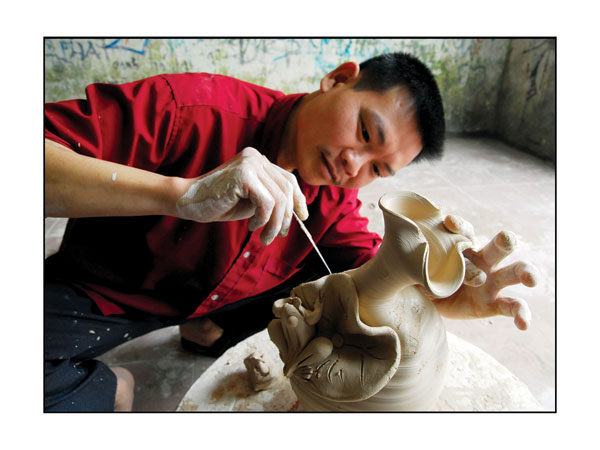(No.9, Vol.6,Nov-Dec 2016 Vietnam Heritage Magazine)
Workers in Bat Trang Village, Gia Lam Dist., Hanoi.
The world keeps turning, and so do the potter’s wheels at Bat Trang
A centuries old trade village
Few trade villages in the country manage to retain former glory and keep on growing, like Bat Trang, Hanoi. Not because it has almost a thousand ceramic making workshops, but also because it has a 5000m2 pottery market that houses hundreds of shops which has been a must-see for the last few years.
Hiding behind Red River levee, 10km to the South of the centre of Hanoi, Bat Trang belongs to Gia Lam District, a suburb of Hanoi. The trade began 5 centuries ago, during the Le Dynasty, which makes it one of the oldest pottery trade villages of Vietnam, with the largest number of kilns (nearly a thousand) of all sizes. Typically, each workshop only makes certain products and follows a certain enamel strand, adding to the diversity of Bat Trang ceramics. Today in Bat Trang, many parts of the pottery making process still remain manual. That helped preserve the human touch in every product, making it so distinct from the industrially made ones.
Pottery products of Bat Trang such as vases, bowls, teapots and statues have been famous for a long time, and not only domestically. Armies of traders come here to buy big lots of them to export to Japan, the Netherlands, France and US, because consumers love the designs, colours and the feel of each item. These products are not only handy, but useful in everyday life. The colour of the enamel is very diverse, ranging from glass enamel, celadon, brown enamel, to rock enamel, crazed enamel and crystallized enamel. Each kind requires a different baking procedure and temperature, from quick 800oC to slow 1200oC.
Bat Trang pottery market
The market opened in late 2014 at the centre of the village. Curious visitors may find it difficult to reach it, because they may get overwhelmed by the forms, colours, patterns and the amount of ceramics that fill courtyards, houses and shops.

Pottery products in Bat Trang Village.
Photos: Lai Dien Dam

It’s very difficult to resist the urge to touch, to feel, to see up close every item, to come into every house, every shop and see how these things are made. How can anyone refuse when some shops offer to guide you through a crash do-it-yourself course so you would forget about the world and roll up your sleeves to play with clay and mud. Some others offer to take you around the village on a buffalo-pulled cart. It takes a lot of determination and discipline to walk through 500-700m of winding village streets to come to the market and see all of it in one place.
I chose for myself a ceramic relief and a vase and was astounded when hearing the price. The two items cost less the VND100,000. The shopkeeper told me, ‘I have a kiln at home, that’s why it’s so cheap. But don’t worry, because the quality is good all the same…’
While many other ceramic trade villages struggle to solve the problems of pricing, marketing, and connecting the dots between the manufacturers and the customers, Bat Trang fascinates visitors with its vibrancy and dynamism. That’s because the notions of love and dedication here include loyalty to traditions, tireless learning to keep pace with the development of new technologies, and sensitivity to market trends. Some families have even managed to revive ancient enamels thought to be lost forever. And so in Vietnam, Bat Trang is a household name that is equivalent to the centuries-old art of pottery and ceramics.
Bat Trang is about 12km from the centre of Hanoi. From anywhere in the city, one can go by bus to Long Bien bus station. From there, one can take bus no. 47 to go to the ceramic trade village. Using one’s own vehicle, one can cross Red River by Chuong Duong, Vinh Tuy or Thanh Tri Bridge, then turn right and follow the river levee until you see the village sign. During weekends, one can also come to Bat Trang by waterways. Many tourist companies offer boat tours to Bat Trang ceramic trade village and Chu Dong Tu temple. Contact tour company for itineraries.

